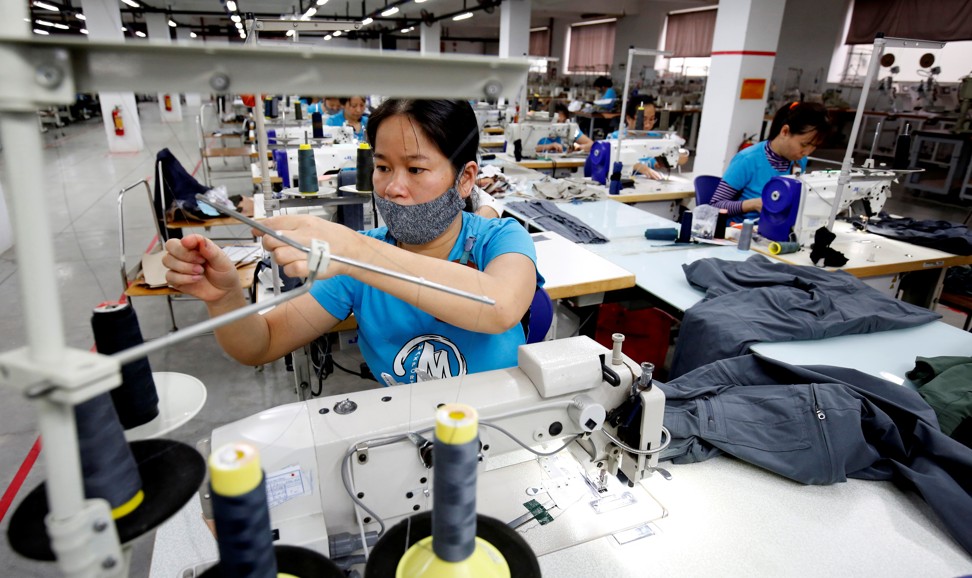
Trade war to hit high-end US fashion brands dependent on specialised Chinese manufacturing
- New US study shows low-end clothing production moving rapidly to Vietnam, Cambodia and Bangladesh, but high-end goods still made in China
- The average retail price of clothing manufactured in China has more than doubled since the start of the trade war
High-end US fashion brands have become more reliant on China for manufacturing, making them more vulnerable to an increase in trade war tariffs, a new study shows.
Research from a professor at an American university shows that other countries, further down the value chain than China, cannot compete on quality on such high-end items, despite the fact many areas of the textiles industry are engaged in a race to the bottom, in terms of costs.
Other countries cannot yet produce in the same quantity or with the same quality as China due to technological constraints.

The report shows that China’s stranglehold on the garment supply chain continues, despite its price advantage being eroded rapidly, due in part to increasing labour costs and the early rounds of US tariffs. The average retail price of clothing manufactured in China was US$25.7 per unit back in the second quarter of 2018, only slightly higher than clothing from Vietnam. A year later, China’s cost more than doubled to US$69.5 per unit.
By the end of the first quarter of 2019, the number of apparel items made in China that were held in US clothing retailers’ inventories were down more than two thirds to 8,352 stock-keeping-units (SKUs), an industry identifier that tracks the attributes of each particular garment.
China still dominated the US retail market as the largest supplier of new clothing items (193,774 SKUs) from the beginning of 2016 to late-April 2019. Vietnam, considered to be China’s main challenger on the cost and quality of garment manufacturing, contributed a third of China’s level to the US market during the same period.
“I don’t think US retailers choose to source from China simply because of cost,” said Sheng Lu, an associate professor of fashion and apparel studies at the University of Delaware and author of the new study. “Rather, China is regarded as a ‘balanced supplier’ with regard to primary sourcing factors, which range from cost, reliability, speed to market, to compliance risk.
“Even though the tariff war will further reduce the price competitiveness of [goods] made in China, it will not fundamentally shift China’s overall competitiveness as a sourcing base, especially in the short-term,” Lu said, in an interview.

The latest proposal to impose tariffs of up to 25 per cent on almost all remaining Chinese exports to the US, valued at US$300 billion by the US government, includes many garment items that were not included in earlier tariff rounds. Those tariffs, which could go into effect in July, will further complicate the sourcing strategy for US fashion brands, Lu said.
“US retailers may quickly move sourcing orders from China to other suppliers for basic fashion items, such as tops, bottoms, and underwear. However, there seems to be much fewer alternative sourcing destinations for more sophisticated product categories, such as accessories and outerwear,” Lu said,
“Ironically, sourcing more sophisticated and higher value-added products from China could make US fashion brands and retailers even more vulnerable to the tariff war because of fewer alternative sourcing destinations.”
Lu analysed real-time pricing and inventory data for more than 300 million items from 90,000 US fashion retailers on a fashion industry database used by brands to adjust their inventory levels and sourcing strategies, as means of maximising sales and profits.
Since August 2017, when the US government launched its Section 301 investigation against China for unfair trade practices, US brands have placed fewer orders for new clothing lines in China.
Vietnam also faced higher cost pressures during the same period, but to a less extent than in China. The average price of garments made in Vietnam rose from around US$20 per unit to US$34.8 per unit. Prices of clothing made in Cambodia and Bangladesh remained below US$20 per unit.
According to Lu, if the US and China impose 25 per cent additional tariffs on each other’s exports of apparel and textiles, it would do little to help US domestic apparel manufacturers, as the US would import more from other suppliers than what they reduce their imports from China, further worsening the overall US trade deficit in the apparel sector.
Still, Chinese manufacturers are increasingly anxious about shrinking orders.
“For clothes factories, there were few orders from the US in April and May, which is usual high season for exporters,” said Liu Kaiming, head of the Shenzhen-based Institute of Contemporary Observation, which monitors working conditions for hundreds of Chinese contract manufacturers.
“Taking a popular US underwear brand as an example, 80 per cent of its apparel was produced by a Hong Kong-owned company in Shenzhen. The company began to redeploy to Vietnam four or five years ago. Last year, due to tariffs, it quickly expanded its investment in Vietnam. Currently, there are four factories in northern Vietnam, accounting for half of their production capacity. If the tariff increases to 25 per cent, there is no doubt that they will move [their production] quickly and more completely,” Liu said.


